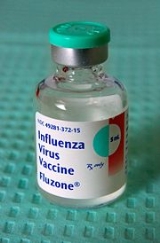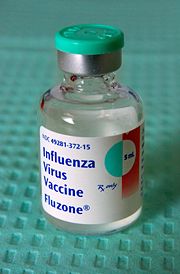
Fluzone
Encyclopedia

Fluzone is the commercial name of an influenza
Influenza
Influenza, commonly referred to as the flu, is an infectious disease caused by RNA viruses of the family Orthomyxoviridae , that affects birds and mammals...
virus
Virus
A virus is a small infectious agent that can replicate only inside the living cells of organisms. Viruses infect all types of organisms, from animals and plants to bacteria and archaea...
vaccine
Vaccine
A vaccine is a biological preparation that improves immunity to a particular disease. A vaccine typically contains an agent that resembles a disease-causing microorganism, and is often made from weakened or killed forms of the microbe or its toxins...
, distributed by sanofi pasteur
Sanofi pasteur
Sanofi Pasteur is the vaccines division of sanofi-aventis Group. It is the largest company in the world devoted entirely to vaccines.- History :...
, USA. It is a split-virus vaccine, which is produced by chemical disruption of the influenza virus. Therefore, it is incapable of causing influenza.
History
As approved by the US Food and Drug AdministrationFood and Drug Administration
The Food and Drug Administration is an agency of the United States Department of Health and Human Services, one of the United States federal executive departments...
(FDA), Fluzone is a preservative
Preservative
A preservative is a naturally occurring or synthetically produced substance that is added to products such as foods, pharmaceuticals, paints, biological samples, wood, etc. to prevent decomposition by microbial growth or by undesirable chemical changes....
-free vaccine administered in a single dose by intramuscular injection. It is presented as a 0.25 ml syringe
Syringe
A syringe is a simple pump consisting of a plunger that fits tightly in a tube. The plunger can be pulled and pushed along inside a cylindrical tube , allowing the syringe to take in and expel a liquid or gas through an orifice at the open end of the tube...
s for pediatric use and 0.5 ml syringes for adults and children. Vials must be stored under temperatures from 2 to 8 degrees Celsius and are inactivated by freezing. Fluzone was approved in April 2002 by the FDA. It is recommended for vaccination against the following type A and B influenza viruses and has been optimized for the 2004-2005 season.
- Type A: New Caledonia 20/99
- Type A: Wyoming 03/2003
- Type B: Jiangsu 10/2003
Fluzone comes in 3 versions that are thimerosal-free. There is a 0.25 ml prefilled pediatric syringe, a 0.5 ml prefilled syringe, and a 0.5 ml vial. There is also a multi-use vial (shown in the picture) that does contain thimerosal.
The optimal vaccination period with Fluzone in the Northern hemisphere is October through November, because influenza activity usually begins in November or December, peaking in late December, and is strongly recommended for people 6 months of age or older. The use of Fluzone in infants less than 6 months of age is not recommended. Immunization
Immunization
Immunization, or immunisation, is the process by which an individual's immune system becomes fortified against an agent ....
with Fluzone may not protect 100% of susceptible individuals.
In January 2011 the FDA recognized that 36 children (out of millions who received the vaccine) from 6-24 months got fevers and seizures within a day of the fluzone vaccine.
Adverse effects
- Mild soreness, local painPainPain is an unpleasant sensation often caused by intense or damaging stimuli such as stubbing a toe, burning a finger, putting iodine on a cut, and bumping the "funny bone."...
and swellingSwelling (medical)In medical parlance, swelling is the transient enlargement or protuberance in the body and may include tumors. According to cause, it may be congenital, traumatic, inflammatory, neoplastic or miscellaneous....
at the local of the injection - In small children and in people with no previous exposure to a flu vaccine, episodes of feverFeverFever is a common medical sign characterized by an elevation of temperature above the normal range of due to an increase in the body temperature regulatory set-point. This increase in set-point triggers increased muscle tone and shivering.As a person's temperature increases, there is, in...
, malaiseMalaiseMalaise is a feeling of general discomfort or uneasiness, of being "out of sorts", often the first indication of an infection or other disease. Malaise is often defined in medicinal research as a "general feeling of being unwell"...
, myalgiaMyalgiaMyalgia means "muscle pain" and is a symptom of many diseases and disorders. The most common causes are the overuse or over-stretching of a muscle or group of muscles. Myalgia without a traumatic history is often due to viral infections...
(muscle pain) - In people who are sensitive to egg protein, allergic reactionsAllergyAn Allergy is a hypersensitivity disorder of the immune system. Allergic reactions occur when a person's immune system reacts to normally harmless substances in the environment. A substance that causes a reaction is called an allergen. These reactions are acquired, predictable, and rapid...
may ensue, such as hives, angioedemaAngioedemaAngioedema or Quincke's edema is the rapid swelling of the dermis, subcutaneous tissue, mucosa and submucosal tissues. It is very similar to urticaria, but urticaria, commonly known as hives, occurs in the upper dermis...
, asthmaAsthmaAsthma is the common chronic inflammatory disease of the airways characterized by variable and recurring symptoms, reversible airflow obstruction, and bronchospasm. Symptoms include wheezing, coughing, chest tightness, and shortness of breath...
and anaphylaxisAnaphylaxisAnaphylaxis is defined as "a serious allergic reaction that is rapid in onset and may cause death". It typically results in a number of symptoms including throat swelling, an itchy rash, and low blood pressure...
See also
- VaccineVaccineA vaccine is a biological preparation that improves immunity to a particular disease. A vaccine typically contains an agent that resembles a disease-causing microorganism, and is often made from weakened or killed forms of the microbe or its toxins...
- VaccinationVaccinationVaccination is the administration of antigenic material to stimulate the immune system of an individual to develop adaptive immunity to a disease. Vaccines can prevent or ameliorate the effects of infection by many pathogens...
- Influenza vaccine
- InfluenzaInfluenzaInfluenza, commonly referred to as the flu, is an infectious disease caused by RNA viruses of the family Orthomyxoviridae , that affects birds and mammals...
- Public healthPublic healthPublic health is "the science and art of preventing disease, prolonging life and promoting health through the organized efforts and informed choices of society, organizations, public and private, communities and individuals" . It is concerned with threats to health based on population health...
- Fluarix
- Fluvirin

